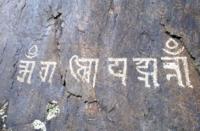You are here
Rock painting in Dolankara.

Pay for a guided tour in Astana.
“He who conquers himself is the mightiest warrior”
Confucius.
Side trip in town Altai near Ust-Kamenogorsk.
The Dolankara Mountains are located 115km south-east of Ayaguz town, 70km southwest of the district capital, Aksuat Village, in the Tarbagaray District of the Eastern Kazakhstan Region, in the south-western spurs of the Tarbagatay Range.
Groups of petroglyph sites are predominantly at the mouths of several gorges on the left bank of the middle reaches of the Bugas River. Research Status and Documentation. The Dolankara Mountains petroglyphs were discovered by artist-regional ethnographer Sadykov S. and studied in 2008 by Rogozhinskiy A.E. who drew up an archeological map of the area and carried out a selective documentation of the petroglyphs.
Archeological Context. The area is classified as mid-hill terrain (1,010-1,070m above sea level) and traditionally used by cattle-breeders as a place for wintering. Different groups of settlements, burial sites, irrigation structures, stelae, statues, petroglyphs and inscriptions are dated to the Neolithic, Bronze Age and early XXth century in a number of gorges.
Cemeteries have the usual stelae with the tamgas of various Kazakh lineages from the Nayman tribe dated to the second half of the XVIIIth - early XIXth centuries. Typology and Dating. Petroglyphs from ancient periods are rare, but include some expressive images of Early Saki art related to the pictorial tradition of “deer” stones.
The most diverse are petroglyphs of the early medieval period, found both on rocks that surround dwelling sites in the mountains and among ancient drawings in isolated locations. Engravings of a chimerical predator and a serpent-dragon overlap Bronze Age bulls.
Medieval tamgas of several types are repeatedly drawn along with traditional hunting scenes near settlements. Tibetan, Oirat prayer inscriptions and various images dated to the middle of the XVIIth - first half of the XVIIIth centuries make a special group.
A panel with engravings depicting Oirat warriors/knights-at-arms and heavily armored riders date to the same period. Scientists from Semipalatinsk found in the mountains Dolankara (Ridge Tarbagatai) the rock painting dated the XVIIth century.
To translate mysterious phrases led to a sensational conclusion - it is the first inscription found to Kazakhstan in Sanskrit. This opening belongs to expert of Scientific center of historical and social political researches of a name of the academic M. Kozybayev at the Semipalatinsk state teacher training college.
Data that in the mountains Dolankara there are mysterious rock paintings were received by the director of the center Mukhtarbek Karimov from the local Murat Ramazanov. This year after long efforts letters were found.
The local Nurlan Zhumagazin who became the conductor in mountains for the specialist of the center Mukhametbek Asylbekov and the teacher of medical university Galymbek Bazarbekov helped. The place was remote, but an inscription is visible already from far away as it was stretched approximately on meter, and height of signs makes 15 cm.
It was the most known Buddhist mantra "Oh Padme khum", written in Sanskrit ("Oh, the pearl shining in lotus heart"). Confirmation of correctness of the translation and conclusions of our experts is already received from the famous expert on Sanskrit, the leading researcher of Institute of history of the Kalmyk Republic (Russian Federation), professor of historical sciences, professor Elza Bakayeva.
Researchers consider that the inscription was made in the XVIIth century. Assume that her author - the outstanding Buddhist scientist, the theologian, the statesman Zaya Pandita. There is a historical version that in 1642 it wintered in these parts.
By the way, he actively participated in promoting of the Buddhism and could make an inscription for this purpose. Mukhtarbek Karimov reminded that northeast, southeast and east part Kazakhstan and in the XVII - XVIIIth centuries was under the power the Zunghar.
To this day in the east of the country there are signs of this era. For example, one of such signs is the fortress monastery of the known Dzungarian great of Amursana under the name "Amirsana of a Zhambyla" in the Tarbagatai.
Or in 1952 silver ingots with the image of the Buddhist Saint were found in the mountains Chingiztau. The toponymics of the region dazzles along with Turkic and Mongolian names. That primordial Turkic lands - Altai, the Tarbagatai, Priirtyshje and the most part of Semirechye - were in certain time as a part of the Oyrat (Dzungarian) state - for anybody not a secret.
Therefore, "The Dzungarian layer" in the history of our region demands a careful research.
Authority:
“Rock Art Sites in Kazakhstan”. Alexey E. Rogozhinskiy. Aygul Bidanova. Town of Semey.
Photo by
Mukhametbeka Asylbekova. Town of Semey.







